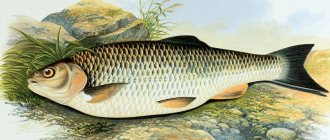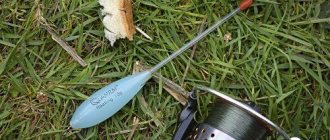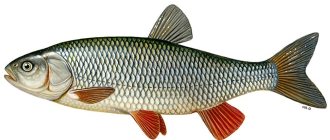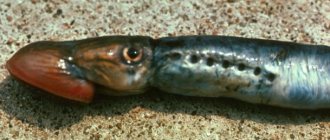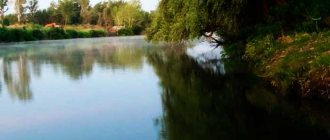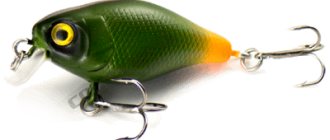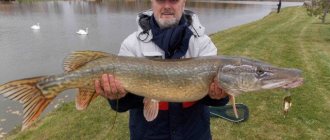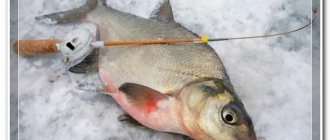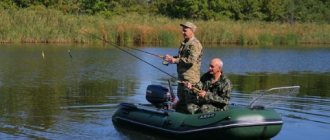Chub fishing is a dynamic type of fishing, regardless of the gear used. After all, a nimble and fast fish discovered by an angler at his anchorage, even with bottom gear, will not allow him to simply sit on the shore waiting for a bite, but will force him to constantly be on the move, changing bait and reacting to sharp and frequent bites. It also helps the angler that this fish is caught throughout the open water season and only catching chub in winter is considered a futile activity. The wide distribution area of this carp species makes it possible to organize fishing trips for catching chub both on small rivers and on large waterways with moderate currents with the same success rate in catching a significant trophy.
Simple equipment for fishing sessions and baits that are mostly common in the fishing environment make catching large chub on the river accessible to most anglers. The topic of the presented article will tell a fisherman who is unfamiliar with the production of this interesting object for catching about the configuration of gear, choosing a promising hunting location and will reveal the secrets of what is the best bait in a particular season of the year.
Features of predator behavior
To catch a chub, you need to be familiar with the basic behavior of the fish. After all, this is a universal species of carp fish, which is an omnivorous fish that feeds on both plant and animal food. Yes, he is not averse to hunting for smaller fish, which often makes up half of his daily diet. The predator’s favorite hunting pattern is a wait-and-see position behind the underwater shelter of a food item floating past, or an insect that has fallen to the surface of the water, which will be picked up and instantly eaten by a swift throw of the fish.
Important! Fish are shy by nature and avoid noisy places. It even leaves its usual feeding points, having noticed extra suspicious activity on the part of the clumsy fisherman.
Unlike many fish species, chubs continue to actively feed during spawning in late May and early June. In warm water they try to stay in the shallows; as the water gets colder, they go to the depths of wintering points and noticeably reduce their feeding activity.
Parking places and fishing times
The chub sticks to rifts, edges, holes and other shelters. But the place should shelter the flock not only from large predators, but also from the current. Look at areas of the reservoir where a fast current is adjacent to a slow current. There is a possibility that this fish is standing here. In addition, you need to pay attention to the places where its tributaries flow into a large body of water. Usually the chub waits in such places for prey brought by the inflow.
You can go fishing immediately after spawning ends. On average, spawning ends in the second ten days of April. But this time may vary depending on the weather or specific area. After spawning, the fish actively feeds. In the summer there is a certain lull, although the vast majority of anglers catch chub at this time. At this time, all types of gear that are used to catch this fast fish work. Autumn is a golden time for fisherman. Since during this period the chub, preparing for the difficult winter time, actively feeds and does not let a single bait pass by.
We recommend reading: Rotan firebrand
It is better to catch chub in the morning and evening dawn. Here he is no different from any other fish. It is in the morning and evening that the highest activity is observed. But if fishing is carried out at the surface of the water, then you can fish even at noon. This statement is especially relevant in the case of catching chub using a tackle with a water ball. During the day, the chub simply basks in the rays of the sun on the surface of the water, but it will also never miss a bait floating by.
At night it is best to catch trophy chub. You can use either a float rod with a firefly or strong bottom tackle. A pleasant bonus of night fishing is that at night a catfish or large carp can easily bite.
Where to catch chub

To search for promising points on rivers, they focus on trees and bushes hanging over the banks, from which all kinds of insects fall into the water. Also ideal are shallow shallows with fast currents, where underwater vegetation stretches in long strands along the current. Knowing the bottom topography, where there are pebble bases with occasional large stones, anglers catch chub by placing bait over such places.
Chub like to stay on the borders of calm and stormy water, standing near a whirlpool or breaker, waiting for an insect that has fallen into the water to float downstream or a small fish tired of fighting fast water. As a rule, promising places can vary in depth from 0.5 to 3 meters.
Gear selection
When winter fishing on currents and ice-free river sections, you can use summer gear: spinning rod, feeder, float rod.

On ice, a winter float rod with a variety of baits is used.
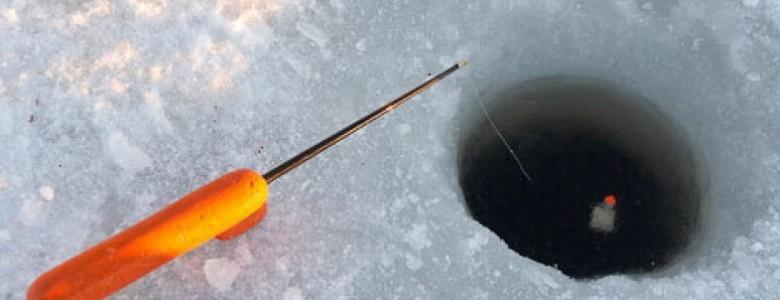
For winter fishing, an ultralight type spinning rod with a dough weight of up to 10 grams is suitable. The optimal rod length is up to 3 meters with a medium action.
When fishing from ice, we recommend using a lavsan nod
When choosing a nod for a spinning rod, you need to take into account its rigidity. A nod made of lavsan, an elastic and durable material that is insensitive to temperature changes, has proven itself well. A stainless steel metal nod would be an excellent choice because of the good signal about the bite and the transfer of low temperatures and the absence of deflections under the influence of the current. The cone shape of the guard helps disperse the sensitivity towards the end of the metal plate from which it is made.
The water movement during the game practically does not affect the tackle itself, but slightly lifts and moves the bait itself, which the chub grabs and pulls the guard downwards. On the lower part of the rod, it is necessary to place the sinker above the hook with the leader.
Equipment in the form of a 0.18 mm main line, a sliding shot, an “olive” and a 0.14 mm leader with a hook number 3.5. The color of the fishing line should be chosen not bright, since the chub has well-developed eyesight, and bright colors can scare it away.
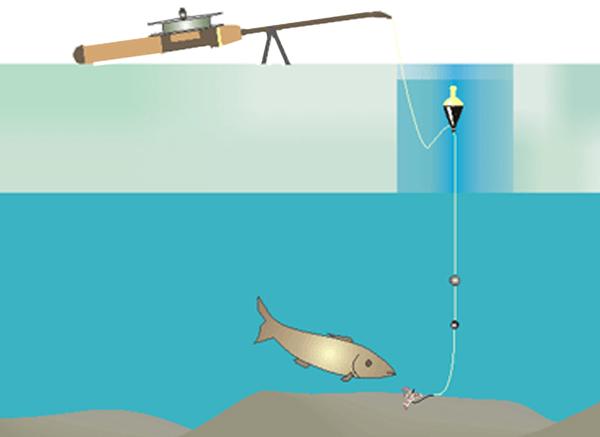
Diagram of a float rod for winter fishing
Suitable baits for spinning are wobblers with minimal movement - minnows and shads. Among silicone baits, choose worm-type twisters and inert slugs. The bait should appear sharply and next to the chub, while the wiring is carried out to drift in the transverse movement of the current or against the current.
Pontoon 21 Red Rag Jackall Chubby Smith Camion SR Yo-Zuri Hardcore Yo-Zuri L-Minnow
It is best when the bait appears unexpectedly in the chub’s field of view and passes as close to it as possible. The correct option for winter wiring would be drifting across the current or upstream.
Peculiarities of biting by season
Chub fishing begins in early spring, after the ice melts, in warm shallow waters. Fish activity increases with increasing water temperature and reaches its peak at the end of May, when schools begin to gather for spawning, continuing to feed throughout the entire mating season.
Important! All summer, when the chub bites relatively consistently and well, is considered the main hunting season. At this time, fish can be caught throughout the day, with greater bite activity in the early morning and at dawn.

In autumn, chubs become more capricious and sensitive to weather changes and especially pressure changes, when the bite can completely disappear and appear only a couple of days after it has stabilized. By November, chub bites become less and less frequent and disappear with the advent of the first significant frosts.
Read the report on chub fishing in December in the Krasnodar Territory.
How to catch chub
Almost all known fishing methods are suitable for catching this wary fish; the main rule is to maintain silence in the fishing area and camouflage the angler. Wade fishing gives good results when hunting in shallow waters. Even when catching chub with a float rod, this method significantly increases catches, since the fish practically does not see the angler, and therefore does not feel any danger. In deep sections of rivers, mining can be successfully done from a boat. Fishing for chub, with a rod and spinning rod, floating downstream and fishing in promising places, constantly produces significant catch results both in terms of the quantity and size of the trophy. We will discuss the most popular fishing methods in detail, considering the main specifics of chub hunting.
Spinning
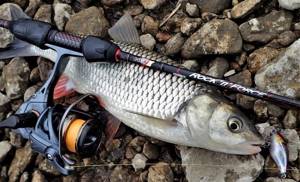
Tackle for chub is selected with the most delicate parameters. Light and ultra-light semi-fast spinning rods are the most suitable tool for this careful hunt. The best results are brought by fishing from boats, which disturbs the caught fish to a lesser extent, therefore spinning rods are used as short in length as possible, equipping them with lightweight spinning reels with a monofilament cord no more than 0.2 mm in diameter. Autumn fishing and spring chub fishing using spinning gear are the most productive hunting times.
Important! During the pre-spawning period and in preparation for wintering, fish become more aggressive and are more likely to attack artificial spinning baits, which are carried out both with classic uniform retrieves and with twitching.
Suitable places for spinning fishing are considered to be areas free of vegetation on the borders with heterogeneous currents and a rocky bottom in water areas with depths of 1–3 meters. To fish places under low-hanging tree crowns, a technique is used to float a floating bait downstream to the end of the prospective fishing path, followed by leading the simulator against the current.
Float tackle
Chub fishing is carried out using a float rod, which is chosen based on the dynamics of fishing in the easiest way. The length of fishing rods for fishing from the shore is taken to be at least 6 meters. Bolognese tackle in the best parameters will provide both casting range and retrieve length. The telescopic fishing rod is equipped with the simplest spinning reel, loading the spools with 50 meters of monofilament fishing line with a diameter of 0.15-0.20 mm.
Important! Stick-type floats with masses of no more than one and a half grams do not alarm fish so much, especially if their color is in natural colors, reminiscent of natural objects that often fall into the water, such as twigs or stems of aquatic vegetation. Therefore, the brown and dark green color of the body of the float with only a bright red tip for greater visibility to the angler are the most suitable options for chub fishing.

The float is loaded with a garland of lead pellets, spreading them along the fishing line to avoid noisy casting and make the equipment more subtle. Leashes 40–50 mm long are set in diameter 0.03 mm thinner than the main fishing line. Hooks are used in the size and color of the bait. The range of hook numbers can vary from 8 to 14 sizes.
Feeder or picker
One of the most promising gear for catching chub in the summer is a feeder rod in one of its lightest varieties, picker. Areas with depths of 3–4 meters can be fished with pickers both conveniently and productively. They fish from the shore, at long distances, using braided line with a diameter of 0.08-0.10 mm as the main line. Feeders are made of plastic, with a total mass that allows you to keep the equipment at the bottom, depending on the strength of the current. Leashes are used monofilamentally, with a diameter of 0.12-0.15 mm, a length of 50-70 mm.
Important! To catch wary fish in the currents, an asymmetrical loop is used as a tying rig, as the most effective and efficient feeder rigging equipment in such conditions.
Donka
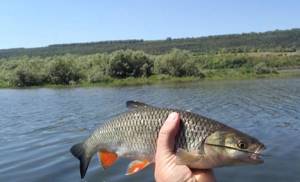
Among the gear for catching chub with live baits, one can distinguish a donka mounted on a spinning rod according to the catch principle. For the base, take a medium action spinning rod 3-3.5 meters long. The rod test should allow you to cast the equipment with a mass that will ensure anchoring of the equipment in the current. Typically, this performance characteristic will be at least 80 grams. The inertia-free reel with a clutch in this equipment plays the role of storing the thread and a device for casting and winding the cord, therefore there are no special requirements for the traction force and gear ratio.
For loading, a sliding lead weight in flat forms is used. A 0.12 mm braided cord ends with a fluorocarbon leader with a diameter of 0.2 mm, with a single hook number 8–10 with a long shank, which helps ensure the installation of live bait fish or small frogs.
Catching chub with a float rod and wire.
Here I will talk about the chub which I mainly caught in the upper reaches of the Don.
On the rivers Don and fast pine. The current on these rivers is very fast, although before it was even faster. Nevertheless, the float moves very quickly. Wiring fishing requires good physical preparation, since you have to throw the tackle very often. The chub belongs to the carp family, differing from other fish by its wider head. The body is elongated, the scales are large, unlike ide. The back is greenish-dark, the sides are silvery, the pectoral fins are orange, the ventral and anal fins are red, the tail and back are almost black. The chub grows quickly and reaches a weight of up to 4 kg with a length of 65 cm. But in Sosna, chubs weighing 1-2.5 kg, with a length of 35-45 cm are usually caught. The largest chub I caught weighed 3 kg 120 g. In our area, chubs spawn from late April to mid-June. But the spawning time is directly dependent on the weather and the opening of the river. Spawning is portioned on rocky or pebble rifts with a fast current. At first, the small ones spawn when the bird cherry tree blooms - “bird cherry”. Then on the twentieth of May - the middle one and when the rye is earing the largest one - “rzhanik”.
Habits and habitats.
Bystraya Sosna River.
The chub leads a correct and methodical lifestyle. It loves sandy, rocky or clay bottoms with fast currents, rocky and sandy riffles, but does not stay on the riffles all the time. Most of the time it stands on the border of a riffle with depth, behind a ledge, where it carries food and weakened fry. Plus it's safer there. The chub is picky and unpredictable when choosing a shelter. If there are overhanging trees on one side, and nearby there are boulders at the bottom, and a little further on there is an island of collected quicksand, he will prefer either the second or the third, because there is a more varied food there and there is a fast current in the neighborhood. And it's safer. He also loves whirlpools, deep pools, and places where two currents merge into one. The location of the chub also directly depends on the weather and time of year. On calm, clear days it stays in the upper layers of the water, and in the summer the wind drives it there in anticipation of big profits. In cold weather, chubs sink to the bottom, and in prolonged bad weather they go into the depths.
How to catch chub.
Caught Chub
For a fisherman, a large chub is a tempting prey. However, catching chub is a difficult task and in most cases requires a thorough knowledge of the habits of this fish and skill. He is very careful, and when caught he strongly resists, forcing the angler to use all his skill and dexterity. Although the chub feeds at night, it is still a more diurnal fish, and therefore it is caught during the day. And since it often stays in the upper layers of the water and is naturally endowed with excessive sensitivity, the angler should not appear in its field of vision and choose the fishing spot this way. So that the shadow of the fisherman and fishing rod does not fall on the water. When fishing with a wire, it is better to stand in the water than on the shore. For some reason, the chub is not afraid of a person with a fishing rod standing in the water, apparently mistaking him for some kind of aquatic object.
Tackle, bait, bait and fishing technique.
Tackle.
Float. Tackle. Sinker and leash. I catch chub mainly by retrieving, sometimes with a feeder. For line fishing, a Bolognese type fishing rod 5-6 meters long, equipped with a Neva reel. The main line is 0.22-0.25 mm. elongated float made of polystyrene foam with a carrying capacity of 8-10 g, sinker - a sliding olive on the main fishing line. A leash with a diameter of 0.13-0.14 mm and a length of 50-60 cm. The leash is attached to the main line using a swivel. On the main line above the swivel I place two stoppers and a sliding sinker. By moving the stoppers, I change the length of the leash and the depth of the wiring. Directly on the leash I attach a small pellet - a podpasok. I place hooks depending on the bait used. For fishing with peas - No. 10 with a short shank, for insects and caterpillars - No. 9 with a long shank. Among insects, the best bait is the dragonfly and its larva - the goose, and among caterpillars - the urticaria. For line fishing, complementary food is very important, which is thrown at the beginning of fishing and at the right time, forcing the chub to go to a certain stream. As a complementary food for all types of bait, I use steamed peas, which I cook exclusively myself. All carp fish love peas and they do not produce turbidity, which is very important when fishing for chub. To deliver peas to the fishing point, I use a spoon of my own design.
Retrieving and hauling techniques.
I place the nozzle 5-10 cm from the bottom. If the bottom is not cluttered and is level, I use a bait that drags along the bottom. At the same time, I install a float with a larger load capacity. When retrieving, it is necessary to ensure that there is no sagging of the line (keep it tight) for timely hooking. Although the lips of a chub are strong and can be hooked strongly, in order to avoid breaking the leash it is necessary to hook with a gentle movement of the hand. After hooking, the chub first goes stunned, then there is a jerk, the line rings and all your thoughts are occupied with the fight with the large fish. Even though a chub is a strong and stubborn fish, it is still weaker than a small fish and a fish of the same size, it quickly gets tired, and if you give it a breath of air, it completely weakens and ends up in your net.
Tell your friends about this article
}
onefisherman.ru
What bait is most effective when fishing?
Chub fishing in summer is carried out using bait. The bait should ensure the periodic release of large particles that float downstream, which especially attracts chubs to the fishing point. Fishermen have noticed that one of the most effective bait options is to place the bait downstream five to seven meters from the fishing spot.
Important! As a feeding mixture, ordinary black bread is used, which is crushed when dried and placed in a bag with a cell that allows you to hold the contents in a stream of water until it gets wet.
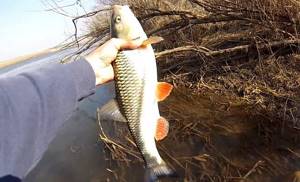
Soaked bread begins to be washed out in different fractions, which ensures the creation of a natural flow of feed particles falling with the current into the fishing zone, where the attracted fish will react to the main bait. Using this method, the feeding bag can be filled with boiled millet porridge with coarse breadcrumbs.
The best natural baits for catching chub
Universal and commercially available natural baits include maggots and small dung worms. But the best baits are considered to be all kinds of insects, which the fisherman has to stock up himself according to the period of their flight. Grasshoppers, cockchafers, butterflies and night crawlers are the usual food of the chub when they are abundantly present near a reservoir. This fish can also be caught using live bait. Bleak and small loaches are the most suitable option. Frog, leech, barley meat and crayfish are also food items that large chubs do not refuse.
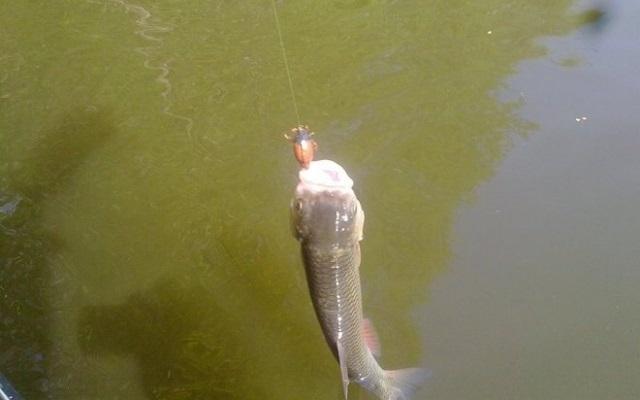
Important! Among the vegetable bait for chub, it is worth highlighting fresh black bread, and I would especially like to note the excellent fishing of chub on the crust, soaked before serving.
The fish takes well on processed cheese, steamed wheat and oats, as well as peas and sweet corn.
Fishing with a water ball
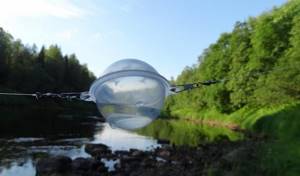
All the main elements of gear for catching chub using a tackle with a water ball are the same as in the case of float fishing. The difference lies directly in the equipment itself. Instead of a float, a water ball (water-filling float) is tied to the fishing line. A water balloon is a special transparent float with two valves. Using the first valve, you can draw water inside the ball, and using the second valve, the angler can drain this water. It is through these valves that the weight of the water ball is regulated.
It is especially worth noting that the water balloon is made of transparent material. Most often this material is plastic. Sometimes there are also water balloons made of glass. The leash can go either before or after the water ball. In any case, the water ball is always on the surface of the water. The bait will also be located here.
We recommend reading: Taimen fish, description
In the case of a water ball, it is better to use thin wire hooks. After all, such hooks will not drag the bait into the depths. When fishing with a water ball, it is wise to use insects as bait, which are the natural food of the chub at a particular time. The cockchafer, grasshopper, locust, dragonfly and other insects perform best in this role. Before fishing, fishing enthusiasts pay attention to the shores of the reservoir and the insects that are found here. These same insects probably constantly fall into the water and become prey for the chub. So try catching a couple of insects and fishing with them.
A regular float rig can also be used to create something similar to a water balloon rig. In this case, the weights are simply removed from the equipment. The float takes a lying position. Now put the same insect on the hook and move the bait as if fishing with a water ball. Do not place a float with bright colors, as such colors will likely scare away shy fish. But a black or green float will not arouse suspicion among the chub. You can even remove the float and replace it with a simple twig. A small branch will look natural on the water surface and the chub will not suspect a trick.
The disadvantage of using a conventional float as a water balloon is that it is impossible to regulate its weight. The float is light, and therefore it is simply impossible to make a long cast. So there are no full-fledged analogues to the water balloon. By the way, a bread crust would be an excellent bait for catching chub on a water ball. When fishing like this, you also catch crucian carp, carp, roach and bream.
What to catch chub with
Truly sporty and exciting chub fishing is considered to be fishing using artificial baits. Today the fishing industry produces quite a lot of specialized baits specifically for this fish. Next, we will look at the main trends in this area, describing the features of choosing bait and the characteristics of the best options for artificial chub baits.
Wobblers
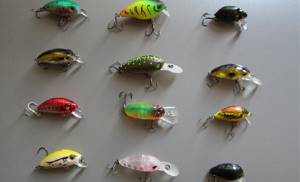
Small fats with slight depth are considered specialized wobblers for chub. Fats of various colors with their own small-frequency play are suitable for fast and energetic retrieves. Manufacturers produce wobblers of this type not only in fish imitations, but also in all kinds of beetles, grasshoppers, flies and bees. Fat sizes ranging from 3–5 cm in length and weight of no more than five grams are considered optimal tools for spinning chub fishing.
Read more about choosing wobblers for chub, as well as about implementing fishing techniques.
Some variants of mines no longer than 4–5 cm also show good mining results when twitching. The performance characteristics of both types of wobblers differ in their depth limit from half a meter to two and are available in a floating type. An active fish picks up the wobbler even when it falls on the water, even before the start of the retrieve. When fishing, the bite is characterized by a sharp blow with the predator immediately retreating into the depths.
Spoons
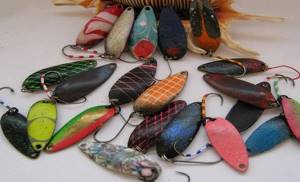
Among spinners, the preferred variants are rotating ones with a drop-shaped petal and its distinct silver color. It is to the glare of the petal that the active predator reacts. Rotating spoons move through the water without touching the bottom even after casting. The bite is completely identical to the fish entering the wobbler. When using oscillating spoons, preference is given to narrow products up to five centimeters long, with the same silver coating.
Other baits
Among other baits, it is worth noting all kinds of artificial knitted flies and beetles, which are used in fly fishing, and are also used to catch chub on a fishing rod. Artificial imitations of insects should have bright, non-wet plumage and should not exceed the size of their real counterpart. Place the fly on the water and wait for a bite, slightly twitching the bait. When the fish are highly active, it is enough to release the bait with the current and watch for its selection by the predator.
Chub baits and lures
The predator bites best on baits that it can find naturally. Another popular group of baits are those that imitate the fish that the chub feeds on, or insects that have fallen into the water. You should use thinner hooks for animal types of bait and thicker ones for plant baits.
Catching chub on:
- May beetle. The cockchafer bait performs best from mid-April to early May, when the most active flight of the insect occurs. Carp, carp, and catfish are also caught with bait;
- grasshopper It replaces the previous bait, since the activation of the insect’s flight begins after the end of the hunting season for the cockchafer. With the correct attachment, the technique ensures a good catch and is not inferior to the Khrushchev. It is important to take large grasshoppers, then the likelihood of catching a trophy individual increases significantly;
- wobbler The predator grabs a wide variety of species, but there are also the best wobblers for chub. In spring it is best to use Jackall Chubby, in summer the choice falls on Yo-Zuri L-Minnow 44S, and in autumn Lucky Craft Bevy Crank 45DR;
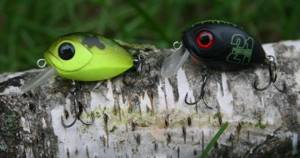
The chub is a half-predatory fish, so it is caught using various baits of animal and plant origin.
- cranks. The tendency of fish to pick up insects that have fallen on the water can be used against it; crankbaits will help with this. Such surface lures are especially effective when moving close to fish. The Moca 25SR model has proven itself best, but Sonic Cara and Peppy 27F are also popular;
- chicken liver. Many people believe that it is better to bait a liver slightly treated with boiling water, but this loses the very essence of the bait. Catching chub with the liver is successful due to the fact that blood particles are still released from the liver tissue, which carry the smell throughout the reservoir even at a shallow immersion depth. The smell attracts predators even from other areas of the reservoir;
- microoscillators. Spinner spoons should be used in strong currents; this is where their play is at its best. Micro-oscillators require wiring. Initially, smooth movements are tried, if they are ineffective, stepwise wiring is used. Best options: THOMAS EEL, MYSTIC JUKE, FOREST CRYSTAL;
- flies. This chub bait resembles various midges and other flying creatures that have fallen into the water. The predator begins to feed on them immediately after the water warms up; already with the first warming, the number of flies becomes countless. The fish are losing caution and there are confident chub bites on 3 main flies: brown caddis, March Brown and Red Tag;
- crust of bread Fish can be caught not only with animal bait, since the chub is an omnivorous species. In combination with this bait, it is worth using several others, since the tastes of fish in different bodies of water, and even areas, may differ;
- live bait The effectiveness of baiting a predator lies in the peculiarities of its behavior in late summer and autumn. In these times, when the number of insects decreases and food for the predator becomes scarce due to great competition and lack of falling prey, the chub looks for other methods of feeding. There are many toads on the river bank, and in the reservoir itself there are smaller fish, this becomes the main food of the predator. For successful hunting, it is important to determine the type of fry that is the largest in the reservoir. With this species you will be able to catch the maximum number of fish;
- peas. The fish feed throughout the day and respond well to various baits; you can also try peas. If you can’t get a bite from steamed or fresh peas, you should throw peas into the predator’s habitat for several days as bait. Chub go well with peas in spring and summer; in autumn it is an ineffective bait;
Read more
How to properly load a float?

It is worth noting that large chub eat almost everything that gets into the water, from berries to fry and small rodents
- turntable. Rotating spoons are used in both small and medium sizes. The predator can be picky, and in order not to return home empty-handed, you should have 7-10 varieties of spinners in stock. Catching chub with a spinner spoon is most successful with the following bait models: Mepps Aglia, Myran Agat, Blue Fox Super Vibrax;
- cockroaches The cockroach bait differs little from other methods of fishing for insects. You can buy it (Imakatsu abe yanma) or make it yourself.
With so many baits, there is no need for other baits to catch a predator. Any of the listed methods will help to achieve an active bite.
